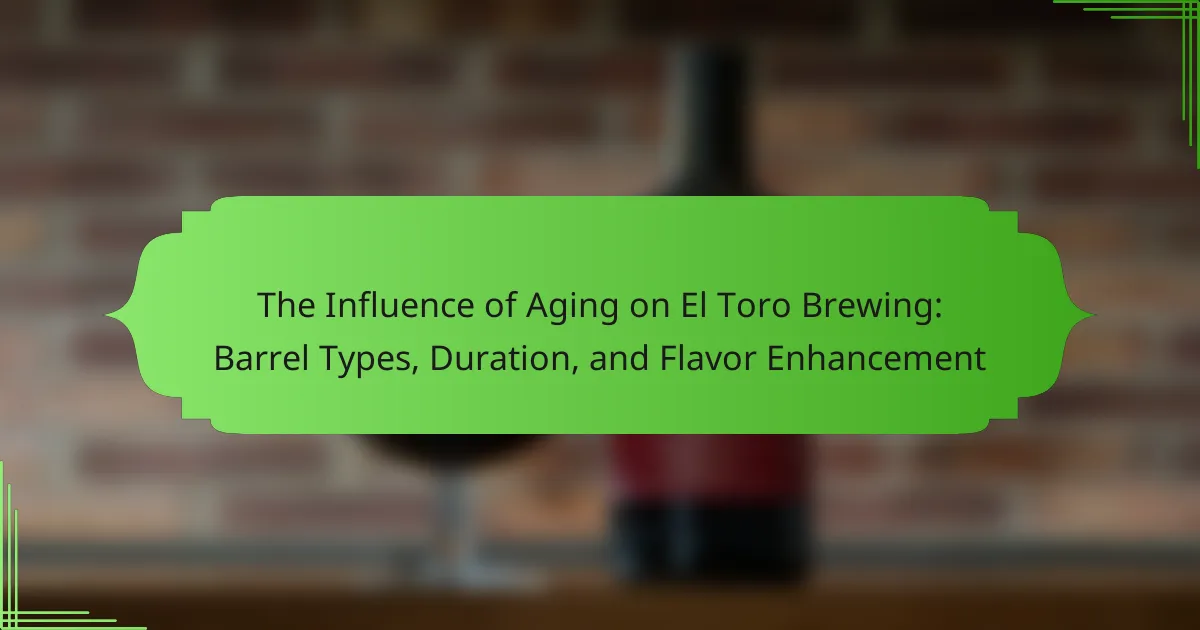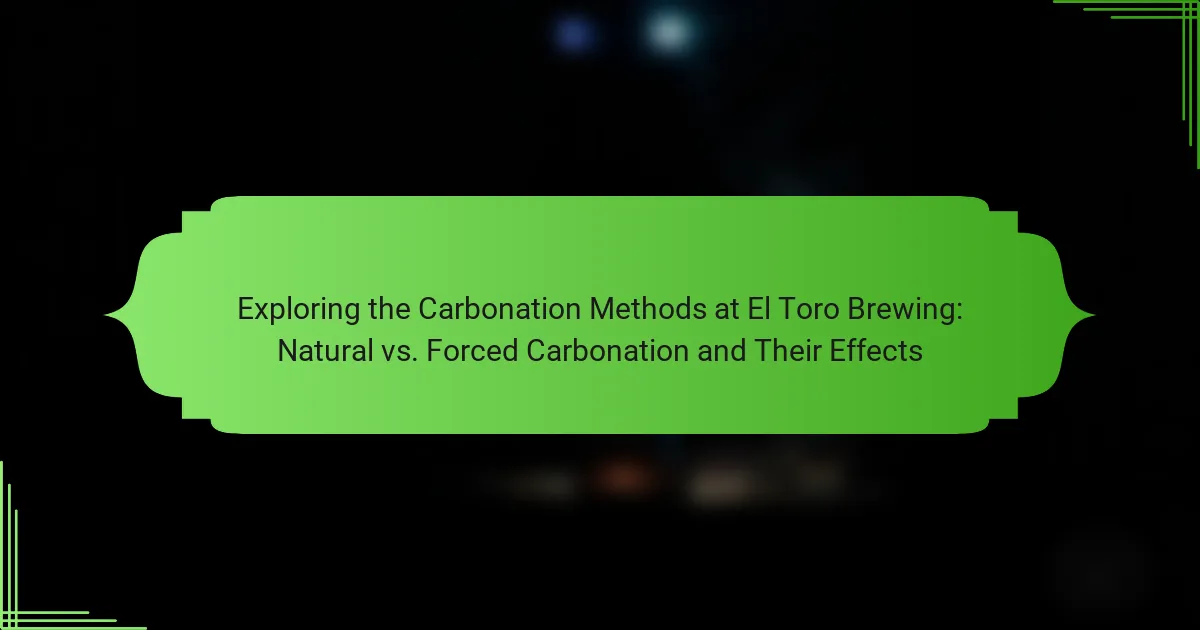El Toro Brewing specializes in crafting unique beers through a meticulous aging process that takes place in various types of barrels. This aging process enhances flavor complexity and aroma by allowing the beer to interact with the wood, resulting in distinctive notes such as vanilla, oak, and spice. The duration of aging is crucial, as longer periods can lead to a deeper integration of flavors and a smoother finish. Additionally, different barrel types, like bourbon or wine barrels, contribute specific characteristics that further enhance the beer’s quality. Research indicates that the optimal aging duration varies by beer style, impacting the overall balance and depth of the final product.
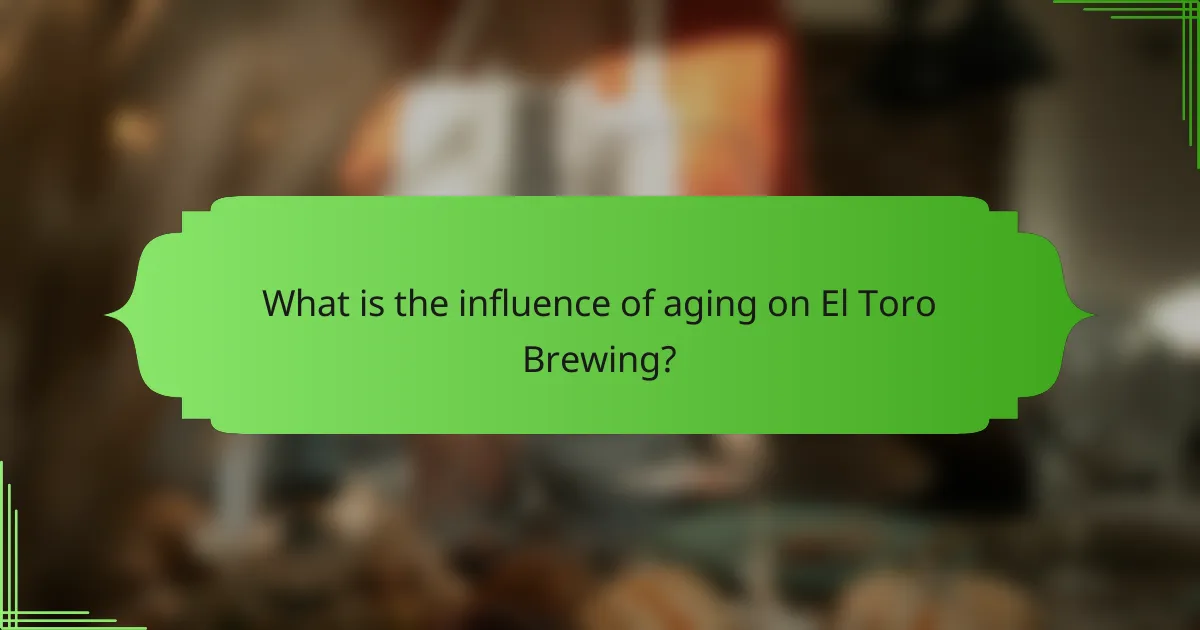
What is the influence of aging on El Toro Brewing?
Aging influences El Toro Brewing by enhancing flavor complexity and aroma. The aging process allows the beer to interact with the wood of the barrels. This interaction can impart unique characteristics such as vanilla, oak, and spice notes. Different barrel types, such as bourbon or wine barrels, contribute distinct flavors. The duration of aging also plays a critical role. Longer aging periods can lead to more pronounced flavors and smoother finishes. Studies show that aged beers often have improved balance and depth. This process is essential for creating unique and high-quality craft beers.
How does aging affect the brewing process at El Toro?
Aging significantly impacts the brewing process at El Toro. It enhances flavor complexity and depth in the final product. The aging process allows the beer to develop richer aromas and smoother textures. It also promotes the integration of flavors from the barrel used. Different barrel types contribute unique characteristics to the brew. For instance, oak barrels impart vanilla and spice notes. The duration of aging can further intensify these flavors. Studies show that optimal aging can improve the overall quality of the beer.
What are the key stages of aging in the brewing process?
The key stages of aging in the brewing process include initial fermentation, maturation, and conditioning. Initial fermentation occurs when yeast converts sugars into alcohol and carbon dioxide. This stage typically lasts one to two weeks. Maturation follows fermentation. During maturation, the beer develops its flavors and aromas. This stage can last from several weeks to several months, depending on the style of beer. Conditioning is the final stage of aging. It involves the beer being carbonated and clarified. This stage can take a few days to several weeks. Each stage is crucial for flavor development and overall quality.
How does the aging process differ for various beer styles at El Toro?
The aging process at El Toro varies significantly among different beer styles. Lighter beers, like lagers, typically age for shorter periods, around 4-6 weeks. This brief aging helps maintain their crisp and refreshing characteristics. In contrast, darker beers, such as stouts, may age for several months to enhance their complex flavors.
Barrel types also influence aging. For example, bourbon barrels impart distinct vanilla and oak notes to the beer. This is especially true for imperial stouts aged in bourbon barrels.
Sours and wild ales often undergo extended aging, sometimes lasting over a year. This process allows for the development of tartness and depth.
The specific duration and barrel selection are crucial for flavor enhancement. Each style’s unique attributes dictate its optimal aging process at El Toro.
What are the different barrel types used in El Toro Brewing?
El Toro Brewing uses several types of barrels for aging its beers. Common barrel types include bourbon barrels, wine barrels, and rum barrels. Bourbon barrels impart rich vanilla and oak flavors. Wine barrels can add fruity and tannic notes. Rum barrels contribute sweetness and spice. Each barrel type influences the final flavor profile of the beer. The use of these barrels enhances complexity and depth in El Toro’s brews.
What characteristics do various barrel types contribute to the aging process?
Different barrel types contribute unique characteristics to the aging process of beverages. Oak barrels, commonly used, impart vanilla and caramel flavors due to their lignin content. The charred interior of these barrels enhances flavor complexity and adds smokiness.
Bourbon barrels, which are often reused, provide notes of sweetness and spice from the residual whiskey. European oak barrels, used for aging wines, introduce tannins and fruitiness, influencing the final flavor profile.
Stainless steel barrels, while not traditional for aging, preserve freshness and allow for controlled fermentation. Each barrel type affects oxidation rates, which can alter the beverage’s color, aroma, and taste.
Research shows that the type of wood and its treatment significantly impact the chemical composition during aging, thereby affecting flavor development.
How does the choice of barrel impact the final flavor profile of the beer?
The choice of barrel significantly impacts the final flavor profile of the beer. Different types of barrels impart unique flavors due to their wood characteristics. For example, oak barrels can add vanilla, caramel, and spice notes. The previous contents of the barrel also influence flavor; whiskey barrels may impart smoky or fruity notes. Additionally, the level of charring inside the barrel affects the flavor, with heavier charring contributing more intense caramelization. The duration of aging in the barrel further enhances these flavors, allowing for deeper integration. Research shows that barrel aging can increase complexity in beer, making it more nuanced and layered. Thus, the selection of barrel type and aging duration are critical in determining the beer’s final taste.
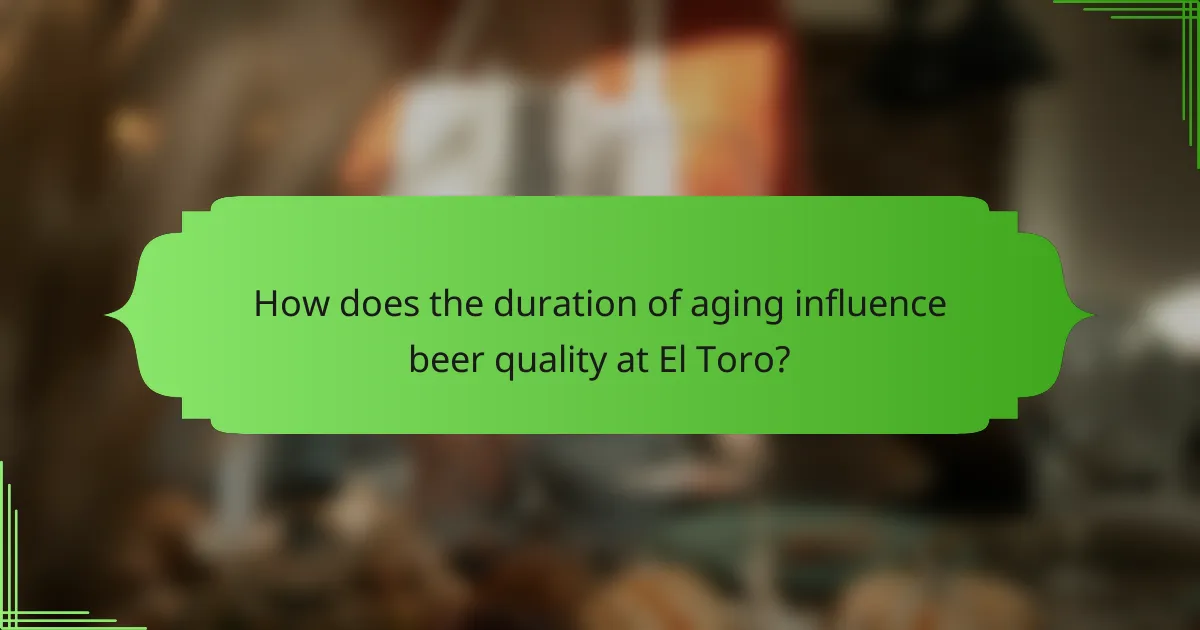
How does the duration of aging influence beer quality at El Toro?
The duration of aging significantly influences beer quality at El Toro. Longer aging periods typically enhance the complexity of flavors. This process allows for deeper integration of ingredients and the development of unique taste profiles. For instance, aging in specific barrel types can impart distinct characteristics such as oakiness or vanilla notes. Research indicates that optimal aging durations can vary depending on the beer style. Studies show that some styles benefit from several months of aging, while others may peak in flavor after just a few weeks. The balance between aging duration and beer style is crucial for achieving the desired quality at El Toro.
What are the effects of short-term aging on El Toro beers?
Short-term aging on El Toro beers primarily enhances flavor complexity and smoothness. This process allows the beer to develop richer, more nuanced flavors. During short-term aging, the interaction between the beer and the barrel can introduce subtle notes of vanilla, oak, or caramel. Additionally, the aging process can help mellow harsh alcohol flavors, resulting in a smoother mouthfeel. Research indicates that even brief aging can improve the overall balance of the beer. The temperature and humidity during aging also play a role in flavor development. Therefore, short-term aging can significantly enhance the drinking experience of El Toro beers.
How does flavor development differ in short-term aged beers?
Short-term aged beers typically exhibit fresher and more vibrant flavors compared to long-aged counterparts. This aging process allows for initial interactions between the beer and the barrel, infusing subtle oak characteristics. During this time, the beer retains its hop profile, resulting in pronounced bitterness and aroma. Additionally, short-term aging can enhance fruity esters, contributing to a more lively taste. The balance between malt sweetness and hop bitterness is often more pronounced in these beers. Research indicates that flavors develop more rapidly in short-term aging due to less oxidation. This limited exposure to air preserves the beer’s original character while introducing mild complexities.
What are the risks associated with short aging periods?
Short aging periods can lead to several risks in brewing. One major risk is insufficient flavor development. Beers may lack complexity and depth without adequate aging time. Another risk is the potential for off-flavors. These can arise from unbalanced fermentation processes that short aging fails to rectify. Additionally, short aging may not allow for proper integration of ingredients. This can result in a disjointed taste profile. Moreover, the risk of oxidation increases. This can negatively impact the beer’s aroma and freshness. Finally, microbial instability can occur. Short aging may not provide enough time for unwanted organisms to be eliminated.
What changes occur during long-term aging at El Toro?
Long-term aging at El Toro results in significant changes to the beer’s flavor profile and characteristics. The aging process allows for the development of complex flavors, including notes of oak, vanilla, and caramel. These flavors emerge from the interaction between the beer and the wood of the barrels. Additionally, the beer undergoes oxidation, which can enhance aroma and soften harsher flavors. The alcohol content may also evolve, potentially becoming smoother over time. The duration of aging impacts these changes, with longer periods typically leading to more pronounced characteristics. Studies show that barrel types, such as bourbon or wine barrels, further influence the final flavor outcome.
How do flavors evolve over extended aging periods?
Flavors evolve over extended aging periods through chemical reactions and interactions within the aging medium. During aging, compounds in the beverage interact with wood, oxygen, and other elements. This process can lead to the development of complex flavors such as vanilla, caramel, and spice. Tannins from the wood can soften, enhancing mouthfeel and balance. Oxidation can introduce nutty or fruity notes, altering the overall profile. Studies show that certain flavors peak after specific aging durations, indicating a timeline for optimal taste. For example, whiskey often reaches its flavor zenith after 5 to 12 years in barrels. Thus, aging significantly impacts flavor complexity and depth.
What are the best practices for long-term aging in brewing?
The best practices for long-term aging in brewing include selecting the right barrel type, maintaining optimal storage conditions, and monitoring the aging process. Using oak barrels is common due to their ability to impart flavors. Temperature control is crucial; a consistent cool environment helps prevent spoilage. Humidity levels should also be monitored to avoid barrel drying. Regular sampling is essential to assess flavor development. Proper sanitation of barrels prevents contamination. Aging duration varies; some beers benefit from several months, while others may require years. These practices ensure that the beer develops complex flavors and aromas over time.
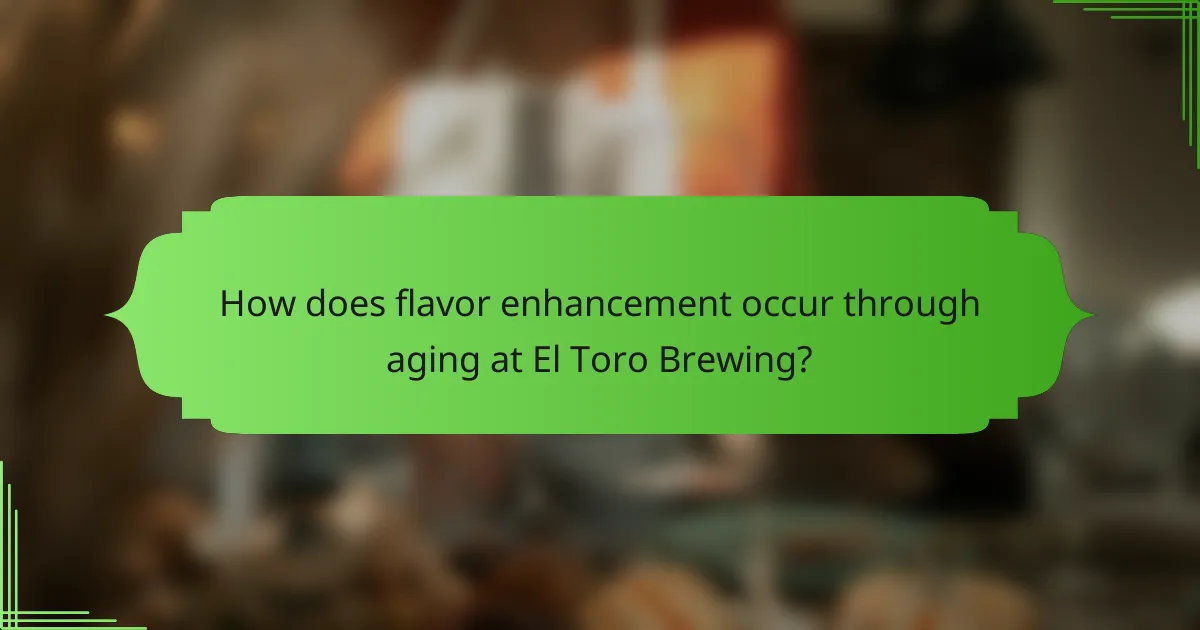
How does flavor enhancement occur through aging at El Toro Brewing?
Flavor enhancement at El Toro Brewing occurs through the aging process in barrels. The interaction between the beer and the wood of the barrels develops complex flavors. During aging, compounds from the wood are extracted into the beer. These compounds include vanillin, which adds sweetness, and tannins, which provide structure. The duration of aging also plays a crucial role. Longer aging periods allow for a greater depth of flavor. Additionally, different barrel types impart unique characteristics. For example, bourbon barrels may add notes of caramel and oak. This careful aging process results in a more refined and flavorful beer.
What flavors are typically enhanced through the aging process?
Aging typically enhances flavors such as vanilla, caramel, oak, and spice. These flavors develop as the beverage interacts with the wood of the barrels. The process allows for the extraction of compounds from the wood. For example, vanillin from oak contributes to a vanilla flavor. Caramel notes can emerge from the breakdown of sugars during aging. Additionally, the aging process can introduce tannins that add astringency and complexity. These flavor enhancements are often sought after in beverages like whiskey, wine, and craft beer.
How do different barrel types influence flavor enhancement?
Different barrel types significantly influence flavor enhancement in beverages. Each barrel type imparts unique characteristics based on its wood type, toasting level, and previous contents. For example, American oak barrels typically add vanilla and caramel notes due to their high lactone content. French oak barrels, on the other hand, contribute spicier and more complex flavors, often enhancing fruitiness.
The toasting process also affects flavor; heavier toasting can introduce chocolate and coffee notes. Additionally, barrels that previously held spirits, such as bourbon or rum, can impart residual flavors from those liquids, further diversifying the flavor profile. Research indicates that the interaction between wood and liquid during aging can lead to significant changes in aroma and taste. This has been documented in studies exploring the impact of barrel aging on wines and spirits, highlighting the importance of barrel selection in flavor development.
What role does oxidation play in flavor development during aging?
Oxidation plays a crucial role in flavor development during aging. It enhances the complexity of flavors in beverages like wine and beer. Oxidative reactions can lead to the formation of new aromatic compounds. These compounds contribute to a richer, more nuanced flavor profile. For example, oxidation can create fruity, nutty, or caramel notes. Studies have shown that controlled oxidation can improve overall taste. In wines, moderate oxidation is often desirable for depth. Research indicates that specific barrel types influence the oxidation process. This interaction can significantly alter the final flavor outcome.
How can brewers optimize aging for flavor enhancement?
Brewers can optimize aging for flavor enhancement by carefully selecting barrel types and controlling aging duration. Different barrel types impart unique flavors due to their wood characteristics. For example, oak barrels can add vanilla, caramel, and spice notes to the beer. The level of toasting or charring on the barrel also influences flavor extraction.
Controlling the aging duration is crucial. Longer aging can deepen flavor complexity but may also lead to undesirable characteristics if overdone. Regular sampling during the aging process allows brewers to monitor flavor development. Additionally, temperature and humidity during aging can affect the interaction between the beer and the barrel, further enhancing flavor profiles.
Research indicates that specific aging conditions can significantly alter the sensory attributes of the beer, contributing to a more refined final product.
What techniques can be used to monitor the aging process effectively?
Techniques to monitor the aging process effectively include sensory evaluation, chemical analysis, and physical measurement. Sensory evaluation involves tasting and smelling the product at various stages. This technique helps assess flavor development and aroma changes over time. Chemical analysis measures compounds such as phenols and esters. These compounds influence the final flavor profile. Physical measurement includes monitoring parameters like temperature and humidity in aging environments. Consistent monitoring of these factors ensures optimal aging conditions. Research indicates that these techniques provide valuable insights into aging effects. For example, a study published in the Journal of Agricultural and Food Chemistry highlights the importance of chemical analysis in understanding flavor evolution during aging.
What are common pitfalls to avoid in the aging process?
Common pitfalls to avoid in the aging process include improper temperature control and inadequate sanitation. Temperature fluctuations can lead to undesirable flavors and spoilage. Maintaining a consistent temperature around 55-60°F is crucial for optimal aging. Poor sanitation practices can introduce unwanted bacteria or wild yeast. This contamination can spoil the batch and ruin flavor profiles. Additionally, over-aging can lead to excessive oak character, overshadowing the beer’s original flavors. It is essential to monitor aging duration closely, typically between 6 to 12 months for most styles. Regular sampling helps assess the beer’s development and ensures it does not age beyond its peak.
What practical tips can be applied for successful aging in El Toro Brewing?
Successful aging in El Toro Brewing can be achieved through careful selection of barrel types. Use oak barrels for their flavor-enhancing properties. Monitor aging duration closely for optimal flavor development. Regularly taste samples to assess progress. Maintain consistent temperature and humidity in storage conditions. Ensure barrels are properly sealed to prevent oxidation. Rotate barrels periodically for even aging. Document aging processes to refine techniques over time. These practices help achieve the desired flavor profiles and quality in aged brews.
The main entity of this article is El Toro Brewing, focusing on the influence of aging on its craft beers. The article outlines how aging enhances flavor complexity and aroma through interactions with various barrel types, including bourbon and wine barrels. It details the key stages of aging, the impact of aging duration on beer quality, and the specific characteristics contributed by different barrel types. Additionally, it discusses the effects of short-term versus long-term aging, best practices for optimizing aging, and common pitfalls to avoid in the brewing process.
